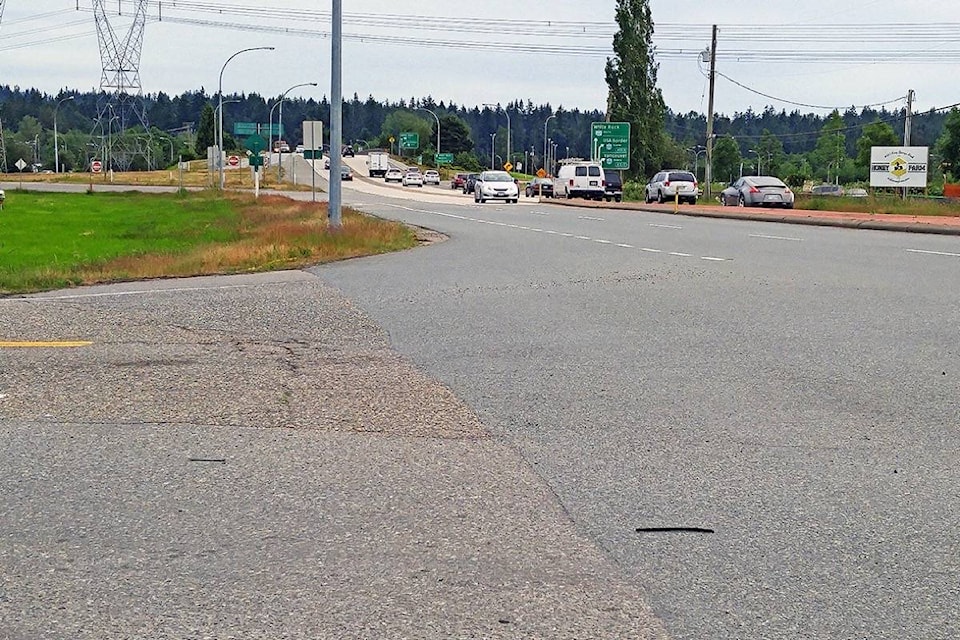A consultant for a developer looking to add hundreds of residential units to Rosemary Heights says there is a $350,000 way for the city to ease concerns around traffic congestion in the South Surrey neighbourhood – install a traffic light at 40 Avenue and King George Boulevard.
The move, Gary Vlieg told members of the city’s traffic and infrastructure committee Monday, would create easier and safer access to the Highway 99 on-ramp for commuters turning left onto King George from 40 Avenue.
And that, Vlieg said, would lead to a change in driver habits that currently see the majority choose to travel 152 Street to the 32 Avenue interchange.
“The signal at King George Boulevard is critical (to alleviating congestion in Rosemary Heights),” Vlieg said. “That left turn is perceived to be too difficult.”
Vlieg, a former traffic operations manager with the City of Surrey, made the appeal on behalf of Porte Communities, which has asked the city for rezoning and other amendments in order to build 269 townhomes and 23 single-family homes on 28 acres at 3690 and 3660 152 St. The site – overlooking the Nicomekl River – is the former home of a Catholic retreat centre.
Area residents have named impacts to traffic, schools and the environment as key concerns with the project.
“The big issue has, and continues to be, traffic,” Vlieg said.
While residents have repeatedly called on the city to halt development – and council last week voted to do just that, temporarily, to examine the issue – Vlieg said “network-level solutions” such as the suggested traffic light could help on a broader scale until long-planned improvements to the 32 Avenue interchange move ahead.
“This is not going to solve all the problems,” he said. “In my mind, it would provide some relief.”
Last July, Peace Arch News learned that a $7.5-million plan for major road improvements in the gridlocked area – the designs for which were first revealed in 2012 – may not get underway until 2021, as ministry funding had been focused on the $24-million 16 Avenue interchange. Completed in 2014, that project replaced an aging two-lane overpass with a six-lane design. The province also lowered the priority of improvements at the 32 Avenue interchange to medium, pushing the start of construction to between 2019 and 2021.
Vlieg said recent studies along 152 Street have shown that the volume of vehicles increases as traffic moves south from 40 Avenue – from around 20,000 per day at that intersection to nearly 30,000 at 32 Avenue.
It’s volume that’s growing by “just shy of two per cent” per year, he said.
“For two-lane roads, you’re at or above capacity.”
By contrast, 40 Avenue is only carrying about 2,000 vehicles per day; spare capacity he encouraged the city to leverage.
Vlieg said a traffic signal at 40 Avenue and King George was also suggested by attendees at Porte’s public information meetings. The cost could be offset by development cost charges from the Porte project for arterial projects, he added, estimating that amount at $2.79 million.
Another congestion-relief option he presented was to remove medians at 40 Avenue and 152 Street – that Vlieg admitted were installed at his own suggestion, during his time with the City of Surrey – and install a traffic light there.
“At the time, it made sense,” Vlieg said of the medians, which prevent through traffic along 40 Avenue.
He estimated the cost of putting a light at that site at between $350,000 and $2 million, due in part to the challenge of significant ditches.
Committee members were not supportive of changes to that site. Coun. Vera LeFranc, citing the road’s importance to cyclists, said the road is “not appropriate” for more traffic. Transportation manager Jaime Boan noted its importance to farmers; as well, that “a lot” had already been spent due to issues with soil settlement.
Coun. Dave Woods said he would prefer to first see a traffic signal at the intersection of 40 Avenue and 176 Street.
Committee chair Coun. Tom Gill told Vlieg the presentation has “given us something to think about.” Any decision would have to be made by council, he said.
Following the presentation, Porte Communities president David Porte emphasized that the suggestions would not just benefit his project.
“It’s a road-network solution,” he told PAN.
“The interchange is tough. Anything that can be done to reduce the traffic from the interchange would benefit the neighbourhood.”
